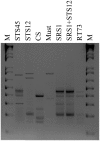Aroma Profile of Montepulciano d'Abruzzo Wine Fermented by Single and Co-culture Starters of Autochthonous Saccharomyces and Non-saccharomyces Yeasts
- PMID: 27199939
- PMCID: PMC4848713
- DOI: 10.3389/fmicb.2016.00610
Aroma Profile of Montepulciano d'Abruzzo Wine Fermented by Single and Co-culture Starters of Autochthonous Saccharomyces and Non-saccharomyces Yeasts
Abstract
Montepulciano d'Abruzzo is a native grape variety of Vitis vinifera L., grown in central Italy and used for production of high quality red wines. Limited studies have been carried out to improve its enological characteristics through the use of indigenous strains of Saccharomyces cerevisiae. The main objective of the present work was to test two indigenous strains of S. cerevisiae (SRS1, RT73), a strain of Starmerella bacillaris (STS12), one of Hanseniaspora uvarum (STS45) and a co-culture of S. cerevisiae (SRS1) and S. bacillaris (STS12), in an experimental cellar to evaluate their role in the sensory characteristic of Montepulciano d'Abruzzo wine. A S. cerevisiae commercial strain was used. Fermentations were conducted under routine Montepulciano d'Abruzzo wine production, in which the main variables were the yeast strains used for fermentation. Basic winemaking parameters, some key chemical analysis and aroma compounds were considered. S. cerevisiae strain dynamics during fermentation were determined by molecular methods. The musts inoculated with the co-culture were characterized by a faster fermentation start and a higher content of glycerol after 3 days of fermentation, as well as the musts added with strains S. bacillaris (STS12) and H. uvarum (STS45). At the end of fermentation the parameters studied were quite similar in all the wines. Total biogenic amines (BA) content of all the wines was low. Ethanolamine was the predominant BA, with a concentration ranging from 21 to 24 mg/l. Wines were characterized by esters and alcohols. In particular, 2-phenylethanol, 3-methylbut-1-yl methanoate, and ethyl ethanoate were the major aroma volatile compounds in all wines. Statistical analysis highlighted the different role played by aroma compounds in the differentiation of wines, even if it was impossible to select a single class of compounds as the most important for a specific yeast. The present study represents a further step toward the use of tailored autochthonous strains to impart the specific characteristics of a given wine which are an expression of a specific terroir.
Keywords: Montepulciano d'Abruzzo wine; Saccharomyces cerevisiae; aroma compounds; autochthonous yeast strains; non-Saccharomyces.
Figures





Similar articles
-
Multistarter from organic viticulture for red wine Montepulciano d'Abruzzo production.Front Microbiol. 2012 Apr 18;3:135. doi: 10.3389/fmicb.2012.00135. eCollection 2012. Front Microbiol. 2012. PMID: 22529841 Free PMC article.
-
The use of indigenous Saccharomyces cerevisiae and Starmerella bacillaris strains as a tool to create chemical complexity in local wines.Food Res Int. 2018 Sep;111:498-508. doi: 10.1016/j.foodres.2018.05.035. Epub 2018 May 21. Food Res Int. 2018. PMID: 30007712
-
Contribution of Starmerella bacillaris and Oak Chips to Trebbiano d'Abruzzo Wine Volatile and Sensory Diversity.Foods. 2023 Mar 4;12(5):1102. doi: 10.3390/foods12051102. Foods. 2023. PMID: 36900619 Free PMC article.
-
Strategies for microbiological control of the alcoholic fermentation in wines by exploiting the microbial terroir complexity: A mini-review.Int J Food Microbiol. 2022 Apr 16;367:109592. doi: 10.1016/j.ijfoodmicro.2022.109592. Epub 2022 Feb 24. Int J Food Microbiol. 2022. PMID: 35240437 Review.
-
The Whiff of Wine Yeast Innovation: Strategies for Enhancing Aroma Production by Yeast during Wine Fermentation.J Agric Food Chem. 2019 Dec 11;67(49):13496-13505. doi: 10.1021/acs.jafc.9b06191. Epub 2019 Nov 25. J Agric Food Chem. 2019. PMID: 31724402 Review.
Cited by
-
Oenococcus oeni Lifestyle Modulates Wine Volatilome and Malolactic Fermentation Outcome.Front Microbiol. 2021 Sep 28;12:736789. doi: 10.3389/fmicb.2021.736789. eCollection 2021. Front Microbiol. 2021. PMID: 34650537 Free PMC article.
-
Starmerella bacillaris Released in Vineyards at Different Concentrations Influences Wine Glycerol Content Depending on the Vinification Protocols.Foods. 2022 Dec 20;12(1):3. doi: 10.3390/foods12010003. Foods. 2022. PMID: 36613220 Free PMC article.
-
Investigating the Effect of Selected Non-Saccharomyces Species on Wine Ecosystem Function and Major Volatiles.Front Bioeng Biotechnol. 2018 Nov 13;6:169. doi: 10.3389/fbioe.2018.00169. eCollection 2018. Front Bioeng Biotechnol. 2018. PMID: 30483500 Free PMC article.
-
Effect of Isomixing on Grape Must Fermentations of ATF1-Overexpressing Wine Yeast Strains.Foods. 2020 Jun 2;9(6):717. doi: 10.3390/foods9060717. Foods. 2020. PMID: 32498265 Free PMC article.
-
A Metagenomic-Based Approach for the Characterization of Bacterial Diversity Associated with Spontaneous Malolactic Fermentations in Wine.Int J Mol Sci. 2019 Aug 15;20(16):3980. doi: 10.3390/ijms20163980. Int J Mol Sci. 2019. PMID: 31443334 Free PMC article.
References
-
- Andorrà I., Berradre M., Rozès N., Mas A., Guillamón J. M., Esteve-Zarzoso B. (2010). Effect of pure and mixed cultures of the main wine yeast species on grape must fermentations. Eur. Food Res. Technol. 231, 215–224. 10.1007/s00217-010-1272-0 - DOI
-
- Barbosa C., García-Martínez J., Pérez-Ortín J. E., Mendes-Ferreira A. (2015). Comparative transcriptomic analysis reveals similarities and dissimilarities in Saccharomyces cerevisiae wine strains response to nitrogen availability. PLoS ONE 10:e0122709. 10.1371/journal.pone.0122709 - DOI - PMC - PubMed
LinkOut - more resources
Full Text Sources
Other Literature Sources

